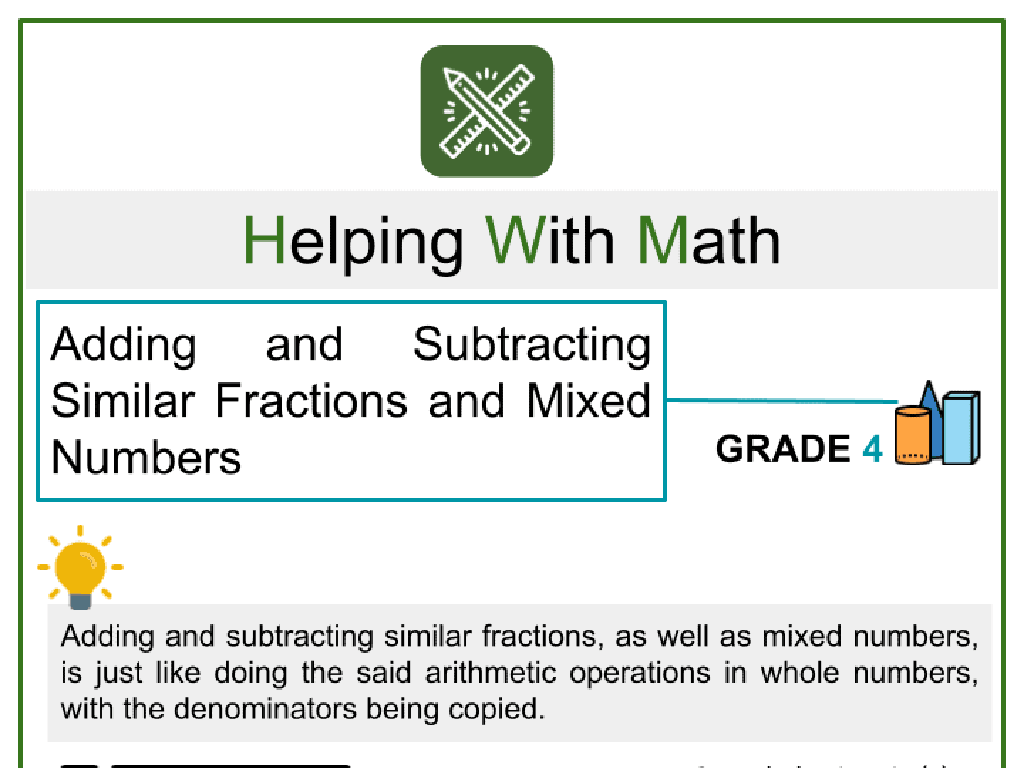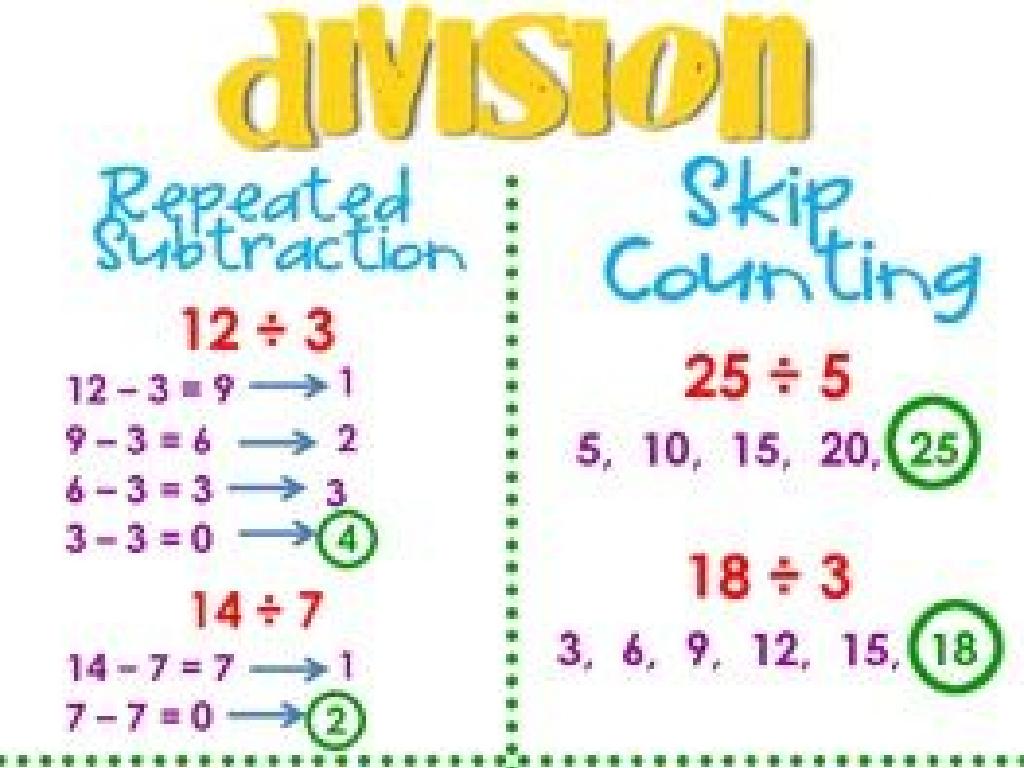Relate Multiplication And Division For Groups
Subject: Math
Grade: Third grade
Topic: Understand Division
Please LOG IN to download the presentation. Access is available to registered users only.
View More Content
Relating Multiplication and Division
– Division creates equal groups
– If you have 12 cookies and 4 friends, division tells you how many cookies each friend gets.
– Multiplication & division are opposites
– If 3 x 4 = 12 in multiplication, then in division, 12 ÷ 4 = 3.
– Use multiplication to check division
– After dividing 12 cookies by 4 friends, multiply 3 cookies per friend by 4 to check.
– Division story problems
– Imagine sharing a pizza equally among friends. How many slices does each person get?
|
This slide introduces the concept of division as making equal groups and its relationship with multiplication. Start by explaining division as a way to distribute items evenly into groups. Show that multiplication and division are inverse operations; one undoes the other. Use simple numbers that students are familiar with for multiplication facts to help them understand division. Provide examples of division as story problems to make the concept relatable. Encourage students to use multiplication to check their division answers. For the activity, consider having students work in groups to solve division problems or create their own story problems that they can solve with division and check with multiplication.
Understanding Division
– Division: Sharing equally
– Division splits a number into equal groups
– Example: 12 apples among 4 friends
– 12 apples divided by 4 friends means each gets an equal share
– Each friend gets 3 apples
– 12 divided by 4 equals 3, so 3 apples per friend
– Division is like reverse multiplication
– If 3 x 4 equals 12, then 12 divided by 4 equals 3
|
This slide introduces the concept of division to third-grade students by relating it to the idea of sharing equally among friends. Use the example of dividing 12 apples among 4 friends to illustrate how division works and to show that each friend gets an equal number of apples. Highlight that division is the process of finding out how many times one number is contained within another. It’s also important to connect division to multiplication by explaining that if 3 multiplied by 4 equals 12, then 12 divided by 4 equals 3. This helps students understand the relationship between these two operations. Encourage students to think of other examples where they share things equally to reinforce the concept.
Multiplication Review: Groups and Arrays
– Multiplication makes groups
– Think of multiplication as adding the same number over and over
– Example: 4 groups of 3 apples
– 4 groups with 3 apples in each group
– 4 x 3 equals 12 apples
– When we multiply 4 by 3, we get 12
– Multiplication is repeated addition
– Instead of saying ‘3+3+3+3’, we can say ‘4 times 3’
|
This slide is a quick review of multiplication as a concept of adding equal groups. Use the example of apples to illustrate this point, as it’s a tangible item children can easily visualize. Explain that multiplication is a faster way to add the same number multiple times. Emphasize that ‘4 groups of 3’ means you have 4 sets that each contain 3 apples. When we multiply these numbers (4 x 3), we find the total number of apples, which is 12. This sets the stage for understanding how multiplication relates to division, as it’s the process of splitting into equal groups.
Multiplication Meets Division
– Multiplication makes groups
– Division splits into groups
– Multiplication and Division connection
– Think of them as opposites: one combines, the other separates
– Example: 4 x 3 and 12 ÷ 4
– If 4 groups of 3 make 12, then 12 split into 4 groups gives 3 each
|
This slide aims to help students understand the relationship between multiplication and division. Start by explaining that multiplication is about combining equal groups to find a total, while division is about splitting a total into equal groups. Emphasize that multiplication and division are closely related; knowing one can help understand the other. Use the example 4 x 3 = 12 to show how multiplication works, then demonstrate that if we have 12 items and want to divide them into 4 equal groups, we would have 3 items in each group (12 ÷ 4 = 3). Encourage students to think of their own examples and to see multiplication and division as two sides of the same coin.
Let’s Practice Division with Oranges!
– 15 oranges and 5 baskets
– How many oranges per basket?
If we share 15 oranges evenly, how many for each basket?
– Divide 15 by 5 equals 3
15 ÷ 5 shows how we split oranges equally
– Each basket gets 3 oranges
We solved it! Every basket has 3 oranges.
|
This slide is an interactive class activity designed to help students understand the concept of division as sharing equally. Start by presenting the problem of dividing 15 oranges into 5 baskets. Ask the students to visualize the oranges and baskets, and guide them through the division process. Encourage them to think about how many oranges each basket would have if the oranges were distributed evenly. After solving the problem together, reinforce the concept that division is an operation that tells us how to distribute things evenly into groups. This practical example helps solidify their understanding of division in a relatable context.
Division in Real Life
– Sharing 20 stickers with 4 friends
– If you have 20 stickers and 4 friends, how do you share?
– How many stickers per friend?
– Divide 20 stickers by 4 to find out
– Division for equal sharing
– Division helps us give out things fairly to everyone
– Division applies in daily life
|
This slide introduces students to the concept of division as a method of sharing equally in real-life situations. Start by posing a relatable question about sharing stickers among friends, which sets the stage for understanding division. Explain that division is the math operation used to distribute things evenly. Use the example of 20 stickers and 4 friends to show how division works: 20 divided by 4 equals 5, so each friend gets 5 stickers. Emphasize that division is not just a math skill but a tool we use to ensure fairness in everyday scenarios. Encourage students to think of other examples where they might use division to share items equally, such as slices of pizza or crayons.
Class Activity: Division Skit with Cookies
– Create a skit on sharing cookies
– Divide into groups for the skit
– Act out equal cookie sharing
– How many cookies does each person get?
– Learn division through play
|
This interactive class activity is designed to help students understand the concept of division in a tangible and engaging way. By creating a skit that involves sharing cookies equally among group members, students will be able to visualize and enact the division process. Teachers should prepare a simple script or scenario for the skit, ensuring that the number of ‘cookies’ and students in each group will require them to divide without remainders. Possible variations of the activity could include groups with different numbers of cookies, or introducing the concept of remainders if appropriate. The key is to facilitate a fun learning environment where students can relate the act of sharing equally to mathematical division.
Wrapping Up: Multiplication & Division
– Great work on multiplication & division!
– Homework: Division worksheet
– Solve the problems to show how division splits groups
– Practice makes perfect
– Keep practicing division at home
|
Congratulations to the students for their hard work in understanding the relationship between multiplication and division. The homework assignment is a worksheet that includes various division problems, which will help reinforce the concept that division is essentially splitting groups into equal parts. Remind students that consistent practice is key to mastering division. Encourage them to try dividing objects at home, like sharing snacks equally with friends or family, to further understand the concept in a practical context.






